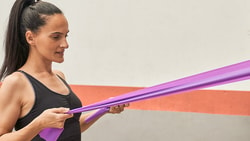Lumbar Radiculopathy: Evidence-Based Diagnosis and Treatment
Clinicians face complex decisions when treating patients with lumbar radiculopathy. This article provides evidence-based strategies to improve diagnosis and guide effective treatment.
September 29, 2025
14 min. read

Lumbar radiculopathy is one of the most impactful patterns within the broader spectrum of low back pain (LBP). Among adults under 45, LBP is a leading cause of disability worldwide and a major driver of healthcare costs and work absenteeism.1 Radiculopathy adds diagnostic complexity, and without accurate classification and timely, evidence-based management, clinicians risk missing red flags, overusing imaging, or applying mismatched lumbar radiculopathy treatments that delay recovery.
The 2012 Low Back Pain Clinical Practice Guidelines (CPG) from The Journal of Orthopaedic & Sports Physical Therapy provide a strong framework for classification and diagnostic strategies, while the 2021 revision updates recommendations for interventions, helping clinicians apply the latest evidence to improve outcomes.
A key feature of these guidelines is the use of the ICF framework to distinguish between low back pain with referred pain and low back pain with radiating pain (radiculopathy)—categories that directly shape diagnostic decisions and treatment planning and serve as the roadmap for evaluating and managing lumbar radiculopathy with confidence.
What is lumbar radiculopathy—and why it matters
Lumbar radiculopathy refers to symptoms caused by irritation or compression of one or more lumbar or sacral nerve roots. Patients may present with radiating pain in a dermatomal distribution, along with sensory changes, weakness, or reflex loss. Careful screening is essential to distinguish these presentations from other causes of leg pain.1
Common contributors include:
Disc herniation: Protrusion of disc material that compresses or irritates adjacent nerve roots.1
Lateral recess or foraminal stenosis: Narrowing of the bony canals where nerves exit, often from degenerative changes.2
Facet hypertrophy: Enlargement of the facet joints that can crowd or compress nearby neural structures.2
Spondylolisthesis: Forward slippage of one vertebra over another, which may reduce foraminal space and increase nerve root compression.3
To manage lumbar radiculopathy effectively, clinicians need to follow a sequence: first, confirm the presentation, then screen for red flags, classify using ICF categories, and finally, implement treatment strategies matched to classification. The following sections will walk you through each step.
Differentiating referred vs. radiating pain (ICF framework)
The first clinical decision point is distinguishing whether a patient’s leg symptoms are referred pain or true radiculopathy. While the 2012 CPG uses the International Classification of Functioning, Disability, and Health (ICF) framework to standardize this distinction, symptom presentation often overlaps between the two categories. Clinicians should rely on their judgment to weigh exam findings alongside patient history, health status, and the broader clinical picture when making this determination, as it directly informs test selection and treatment planning.
Low back pain with referred lower extremity pain
Pain can arise from any innervated tissue of the spine, and does not necessarily follow a dermatomal pattern.
Pain in the lower back, and/or pain in the lower extremity above the knee
Often centralizes with repeated movements or sustained positions (directional preference), meaning symptoms consistently reduce or move proximally in response to certain movements or positions.
Neurological signs are typically absent or minimal.
Low back pain with radiating pain (radiculopathy)
Pain follows a dermatomal distribution
Pain in the lower back and pain in the lower extremity that extends below the knee.
May include paresthesias, sensory changes, weakness, or altered reflexes.
Neural tension tests such as the straight-leg raise (SLR), crossed SLR, or slump test may reproduce symptoms.
Centralization of symptoms can still occur, but is less common; symptoms may peripheralize with loading.
Why does this distinction matter?
Patients with referred pain that centralizes on exam often improve with a directional preference program. Those with true radicular signs may still benefit from repeated movements but often require additional strategies such as graded activity, motor control training, and neural mobilization, with closer monitoring of neurological status.
Key examination cues for differentiation
Once you’ve narrowed down whether the presentation seems referred or radiating, a targeted exam can confirm your classification. The following findings are especially useful for improving diagnostic accuracy at the bedside.
Dermatomes: sensory loss or altered sensation along specific nerve distributions (e.g., L4 = medial ankle, L5 = dorsum of foot/great toe, S1 = lateral foot).
Myotomes: weakness in muscle groups innervated by the affected nerve root (e.g., L4 = knee extension, L5 = dorsiflexion/extensor hallucis longus, S1 = plantarflexion).
Reflexes: diminished or absent reflexes associated with nerve root involvement (e.g., L4 = patellar reflex, L5 = medial hamstring reflex, S1 = Achilles reflex).
Provocation tests:
Straight-leg raise (SLR): Symptoms are typically provoked between 30° and 70°.
Crossed straight-leg raise: less sensitive than SLR but more specific for lumbar radiculopathy.
Slump test: assesses the neural system under load and may reproduce radicular symptoms.
The role of acuity
In addition to distinguishing between referred and radiating pain, clinicians should also consider the acuity of presentation—acute, subacute, or chronic. Acuity modifies both classification and intervention, shaping prognosis and guiding safe treatment choices. For example, acute radiculopathy is often highly irritable, requiring extreme caution with neural mobilization, whereas subacute and chronic stages allow for more progressive approaches.
The following table was adapted from the 2012 CPG:2
Stage | Referred pain | Radiating pain (radiculopathy) |
Acute (less than one month, high irritability) | Symptoms often centralize with repeated movements; emphasize directional preference and pain reduction. | High irritability—avoid early neural mobilization, as it may worsen symptoms. Prioritize education, activity modification, and gentle movement within tolerance. |
Subacute (two to three months, moderate irritability) | Centralization remains key, with progression to strengthening and motor control. | Gentle neural sliders may be introduced; monitor closely for symptom response. Begin graded activity and stabilization work. |
Chronic (greater than three months, lower irritability) | Focus on endurance, function, and recurrence prevention. | Neural mobilization and progressive strengthening are appropriate. Address fear-avoidance, disability, and long-term activity goals. |
By factoring in acuity alongside symptom classification, clinicians can better match treatment intensity to tissue irritability, avoid unnecessary symptom aggravation, and support safer progression.
Red flags and imaging thresholds in lumbar radiculopathy
Before diving into musculoskeletal assessment, it’s essential to rule out severe underlying pathology:
Fracture or compression fracture: history of traumatic injury, osteoporosis, or prolonged corticosteroid use; point tenderness, severely restricted range of motion, positive supine sign test, or positive closed-fist percussion test.
Cauda equina syndrome: saddle anesthesia, urinary retention or overflow, severe or progressive bilateral deficits.
Infection: fever, intravenous drug use, immunosuppression, or recent spinal surgery.
Malignancy: unexplained weight loss, pain at night or at rest.
Rapidly progressive neurologic deficit.
For patients without red flags, early imaging is generally not indicated. MRI without contrast becomes appropriate if focal neurologic deficits persist or worsen, or if symptoms fail to improve after four to six weeks of guideline-based conservative care.1
Additional considerations include:1
X-ray or bone scan when fracture is suspected, particularly in the presence of trauma, osteoporosis, or prolonged corticosteroid use.
MRI with contrast is recommended when infection or prior surgery complicates interpretation.
CT myelography may be used as an alternative when MRI is contraindicated.
Electrodiagnostic studies are reserved for atypical cases or when clinical and imaging findings do not align.
Evidence-based interventions: From classification to care
Once classification is established, lumbar radiculopathy treatment should be tailored to the patient’s presentation. The following recommendations are drawn from clinical practice guidelines and organized by ICF-based categories most relevant to lumbar radiculopathy:2,3
1. Low back pain with referred lower extremity pain (directional preference)
A-level recommendation (exercise therapy): Use repeated movements or sustained positions that centralize symptoms.
Centralization of pain with repeated movements is one of the strongest prognostic indicators for recovery in mechanical low back pain.2 If symptoms improve or move proximally during repeated movement testing, treatment should reinforce that directional preference to optimize outcomes.
Clinical application (by acuity):
Acute: Prioritize centralization with repeated movements. Use extension-biased programs (e.g., prone press-ups) for patients who centralize in extension, or flexion preference strategies (e.g., supine double knee-to-chest) for those with spinal stenosis who centralize in flexion. Address a lateral shift with manual correction, then reinforce using repeated side-gliding in standing.
Subacute (two to three months): Continue directional preference exercises, while progressing to strengthening and motor control to build endurance and restore function.
Chronic (greater than three months): Focus on long-term activity and functional training, including progressive loading and self-management strategies. Teach patients to proactively use these movements at the first sign of peripheralization to reduce recurrence risk.
2. Low back pain with radiating pain (radiculopathy)
A- to C-level recommendations (education, exercise therapy, neural mobilization): Combine patient education, graded activity, motor control, and selective neural mobilization.
Patients with radiculopathy often struggle with disability, fear-avoidance, and functional decline. Education and activity reduce fear, while exercise builds load tolerance. Neural mobilization can provide short-term improvements when irritability is carefully managed.
Clinical application (by acuity):
Acute: Emphasize education, activity modification, and gentle walking or cycling. Avoid neural mobilization due to high irritability. For patients who demonstrate a clear and repeatable benefit, consider mechanical traction in combination with directional preference exercise to reduce leg symptoms.
Subacute: Continue education and activity progression. Introduce gentle neural sliders (e.g., supine sciatic nerve glide) if tolerated, while advancing motor control and graded activity. Mechanical traction may also be appropriate in select patients when paired with exercise to support symptom reduction.
Chronic: Progress to neural mobilization, strengthening, and graded return-to-activity drills (bridging, planks, lunges). Address fear-avoidance and disability with functional strengthening and patient education.
3. Pharmacologic and procedural context (team-based care)
C-level recommendations (pharmacologic and interventional): Consider medications or procedures only when necessary to support function or address refractory symptoms.
Physical therapy is foundational, but in select cases, medical management may be needed to reduce pain to a level where patients can participate fully in rehab.
Clinical application:
Medications: non-opioid analgesics to facilitate activity progression; short oral steroid tapers may provide modest short-term relief in acute radiculopathy.
Procedures: epidural steroid injections for refractory radicular pain; surgical decompression is reserved for progressive neurologic deficits, severe refractory pain with concordant imaging, or cauda equina syndrome.
Team coordination: Communicate with the medical team so therapy interventions remain aligned with broader management plans.
The bottom line is: Interventions are most effective when matched to classification. Prioritize education, exercise, and graded activity, and use adjuncts like manual therapy or neural mobilization only to support active care. Avoid passive modalities that don’t build load tolerance, function, or long-term outcomes.
Additional considerations for movement coordination and mobility deficits
If a patient presents with symptoms of movement coordination or mobility deficits alongside their referred or radiating pain, stabilization or mobility exercises may be added as part of the broader treatment plan. These can include abdominal bracing and supine marching to build motor control, or progressions such as quadruped bird-dogs, planks, and bridging for trunk stability.
When hypomobility contributes to symptoms, lumbar or thoracic mobilization and manipulation can be used in combination with exercise. Follow immediately with repeated movements or stabilization drills to reinforce mobility gains.
From guidelines to guided pathways
Clinical guidelines provide the why and what of evidence-based care. Medbridge Pathways delivers the how, turning recommendations into phased, digital care programs patients can follow between visits.
By linking classification to the right pathway, you can reinforce in-clinic education, scale conservative care across settings, and improve adherence through structured, progressive programs delivered digitally.
For lumbar radiculopathy, Pathways provides four programs that align with guideline-based classifications and intervention strategies:
Low Back Pain – Extension Bias (referred pain, centralization/directional preference): The exercises in this pathway emphasize repeated extension movements that centralize symptoms, progressing from gentle prone press-ups to more advanced core stabilization and functional strengthening.
Low Back Pain – Flexion Preference (referred pain, stenosis-type presentations): Designed for patients who improve in flexion, this pathway integrates flexion-based mobility work (e.g., double-knee-to-chest, seated flexion stretches) with trunk endurance and progressive loading.
Low Back Pain – Radiating (base): For patients with acute or less irritable radicular symptoms, this pathway blends early mobility, neural glides, and foundational strengthening to restore motion and reduce leg symptoms.
Low Back Pain – Radiating (advanced): For more persistent or complex radicular presentations, this pathway advances to higher-level neural mobilization, functional strengthening (bridging, planks, lunges), and graded return-to-activity drills.
How can you use Pathways to elevate your practice?
Reach more patients. Extend conservative care beyond the clinic with hybrid programs that scale evidence-based rehab.
Improve access and adherence. Engage patients between visits with digital programs that reinforce key education and exercise.
Streamline workflows. Triage quickly to the right program, freeing up in-clinic time for higher-level interventions.
Drive better outcomes. Build confidence and consistency by aligning care plans with proven guidelines, reinforced through progressive, trackable pathways.
Case example: Lumbar radiculopathy in action with Pathways
David is a 45-year-old warehouse lead who presented with three weeks of right-sided leg pain radiating below the knee. He reported intermittent paresthesias along the lateral foot and difficulty with prolonged standing and lifting. A red-flag screen was negative, with no signs of systemic illness or progressive neurological deficits.
Exam findings revealed hallmark features of radiculopathy:
Sharp, “shooting” pain down the right posterior-lateral calf into the lateral foot
Lateral shift to the left
Reproduction of symptoms with a right straight-leg raise at 45° and a positive slump test
Diminished right Achilles reflex, mild plantar flexion weakness, and decreased sensation at the lateral foot
No apparent centralization with repeated movements; slight worsening in flexion, minimal change with prone press-ups
These findings supported a classification of low back pain with radiating pain (radiculopathy), likely S1 involvement.
How this patient flows through Pathways
Condition: David reports leg pain and is referred to therapy for evaluation.
Evaluation: The in-clinic exam confirms low back pain with radiating pain (radiculopathy, S1 pattern). Red flags are ruled out, so conservative care is appropriate.
Assignment: The provider assigns David to the Low Back Pain – Radiating (base) pathway. Why this pathway? Because his presentation matches an acute or moderately irritable radicular pattern that benefits from early mobility, gentle neural mobilization, and progressive loading.
Begins pathway: David onboards digitally and starts Phase 1—gentle sciatic nerve sliders, walking intervals, and foundational motor control (bridges, clamshells, abdominal bracing). These build tolerance and reduce sensitivity while reinforcing education from the clinic.
Progress: Over weeks two through six, David advances to Phase 2 and beyond—progressing trunk endurance, hip hinge mechanics, step-downs, and carry progressions. Neural mobilization continues as tolerated. A dedicated Pathways manager tracks his adherence and collaborates with his physical therapist if progress slows.
Complete: By week six, David’s leg pain has decreased in frequency and intensity, his standing and lifting tolerance has improved, and neurological signs are resolving. Had his symptoms failed to improve, his physical therapist and care team would have re-evaluated, considered imaging, or escalated to medical management.
Without support, David might have struggled with adherence or returned to lifting too early. With Pathways, his care was structured, progressive, and transparent—keeping him engaged between visits and giving his provider visibility to adjust care. The result: faster recovery, stronger adherence, and fewer risks of unnecessary escalation.
Turning lumbar radiculopathy guidelines into better care
Lumbar radiculopathy demands a balance of precise classification and evidence-based treatment. The CPGs give you the roadmap: Rule out red flags, apply ICF categories, and match interventions to presentation. When paired with Medbridge Pathways, that roadmap becomes a practical, scalable care model—one that engages patients beyond the clinic, drives adherence, and streamlines workflows. The result is care that’s not only clinically effective but also operationally efficient, helping patients return to function faster while supporting providers in today’s hybrid care environment.
References
Alexander, C. E., Weisbrod, L. J., & Varacallo, M. A. (2024, February 27). Lumbosacral Radiculopathy. In StatPearls. StatPearls Publishing. https://www.ncbi.nlm.nih.gov/books/NBK430837/
Delitto, A., George, S. Z., Van Dillen, L. R., Whitman, J. M., Sowa, G., Shekelle, P., Denninger, T. R., Godges, J. J., & Orthopaedic Section of the American Physical Therapy Association. (2012). Low back pain: Clinical practice guidelines linked to the International Classification of Functioning, Disability, and Health. Journal of Orthopaedic & Sports Physical Therapy, 42(4), A1–A57. https://www.jospt.org/doi/epdf/10.2519/jospt.2012.42.4.A1
George, S. Z., Fritz, J. M., Silfies, S. P., Schneider, M. J., Beneciuk, J. M., Lentz, T. A., Gilliam, J. R., Hendren, S., & Norman, K. S. (2021). Interventions for the management of acute and chronic low back pain: Revision 2021. Journal of Orthopaedic & Sports Physical Therapy, 51(11), CPG1–CPG60. https://www.jospt.org/doi/epdf/10.2519/jospt.2021.0304





